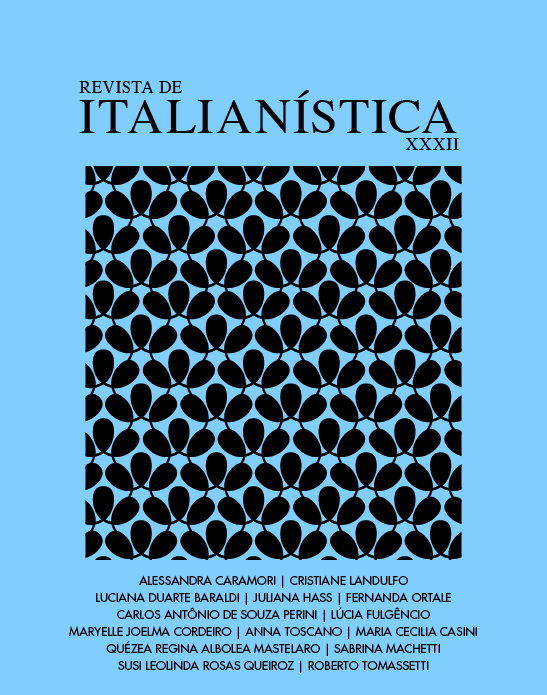Applied Linguistics and Informatics: the intersection of the two areas in the construction of an application for the formation of a database of didactic support in Italian teaching
DOI:
https://doi.org/10.11606/issn.2238-8281.v0i32p37-62Keywords:
Italian language teaching, Online application, Software engineering, CEFR, Scanning didactic material of FLAbstract
In this study we propose an intersection between two fields of study: applied linguistics in teaching/learning italian language and computer science, in order to build an online application that allows the linguistic description and classification of exercises to be used in Italian teaching/learning. The exercises and textbooks inserted into the database and linguistically classified can be retrieved by the application in exercise lists. The didactic material inserted can be catalogued by teachers in two categories: (i) in exercise groups defined by the teacher by level of education, by learning stage, or by linguistic category; and (ii) according to the Common European Framework of Reference (CEFR), following the classification of linguistic skills expected from foreigners, at each level of language competence. By allowing thematic selection of exercises for each skill to be developed, the application assists the teacher in the selection and elaboration of the additional didactic material, which prevents, in the didactic development of the Italian language courses, the teacher not to focus only on the textbook. In addition, the application assists in the classification and sequencing of the didactic material according to the CEFR criteria.Downloads
References
CHIUCHIÚ, A.; CHIUCHIÚ, G. Italiano IN. Vol.1. Perugia: Guerra Edizioni, 2010.
CONFORTI, C. Nuovo Linea Diretta. Vol.1a. Perugia: Guerra Edizioni, 2005.
CONSELHO DA EUROPA. Quadro Europeu Comum de Referência para as línguas (QECR). Aprendizagem, ensino, avaliação. Tradução do inglês de Maria Joana Pimentel do Rosário e Nuno Verdial Soares. Porto/Lisboa: Asa Edições, 2001.
DE MAURO, T. Lessico di frequenza dell’italiano parlato. Milano: Etas Libri, 1993.
FILHO, W. P. P. Engenharia de Software: Fundamentos, Métodos e Padrões. Rio de Janeiro: LTC, 2003.
MAGNELLI, S.; MARIN, T. Nuovo Progetto Italiano. Vol.1a. Roma: Edilingua Edizioni, 2013.
PICHIASSI, M. Apprendere l’italiano L2 nell’era digitale. Le nuove tecnologie nell’insegnamento e nell’apprendimento dell’italiano per stranieri. Perugia: Guerra, 2007.
REVISTA DO ARQUIVO PÚBLICO MINEIRO, Ano XLIII, nº 1, Jan.-Junho 2007, p. 160. Disponível em: http://www.siaapm.cultura.mg.gov.br/modules/rapm/search.php. Acesso em: 05 mai. 2016.
SANTOS, R. A aquisição da linguagem. In: FIORIN, J. L. (org.), Introdução à Linguística – Objetos Teóricos, São Paulo: Contexto, 2002, p. 211-226.
SCIARONE, G. Vocabolario fondamentale della lingua italiana. Perugia: Guerra Edizioi, 1995.
SPINELLI, B.; PARIZZI, F. Profilo della lingua Italiana. Firenze: La Nuova Italia, 2010.
ZAMBALDE, A. L.; PÁDUA, C. I. P. S. O documento científico em Ciência da Computação: suas partes e sua redação: estudo e análise em uma Instituição Federal de Ensino Superior. 2006. Disponível em: http://algol.dcc.ufla.br/~zambalde/aulas/02_COM211_ArtigoExemplo.doc. Acesso em: 05 mai. 2015.
ZIGLIO, L.; RIZZO, G. Espresso. Vol.1. Firenze: Alma Edizioni, 2003.
ZUANELLI, E. Comunicazione Digitale. Un approccio semiologico-linguistico. Roma: Colombo, 2009.
Downloads
Published
Issue
Section
License
Copyright (c) 2016 Revista de Italianística

This work is licensed under a Creative Commons Attribution-NonCommercial-NoDerivatives 4.0 International License.
A revista retém os direitos patrimoniais dos artigos e os publica simultâneamente sob uma Licença Creative Commons-Atribuição-Não Comercial-Sem Derivações.



